Selden Connor Gile stands as a pivotal figure in the story of early 20th-century American art, particularly within the vibrant landscape of California Modernism. An artist celebrated for his exuberant use of color and expressive depictions of the Golden State's scenery, Gile was not only a talented painter but also a central force in one of the region's most influential art groups, the Society of Six. His life and work offer a fascinating window into the development of a distinctly Californian artistic identity, breaking away from academic traditions to embrace bold, personal expression.
Born in the small town of Stow, Maine, in 1877, Gile's early life was rooted in New England. While details of his initial art training remain somewhat debated by historians, sources suggest he may have received some instruction in Boston and possibly New York after attending business college in Maine. However, his artistic destiny truly began to unfold when he made the significant decision to move west, arriving in California around 1901. Settling initially in or near Oakland, across the bay from San Francisco, he found himself immersed in a landscape dramatically different from that of his youth.
California Beckons: A New Landscape, A New Vision
The California that greeted Selden Gile at the turn of the century was a land of dynamic growth and stunning natural beauty. The unique quality of light, the rolling hills, the sparkling bay, and the burgeoning communities provided fertile ground for an artist seeking inspiration. Gile, like many artists drawn to the state, was captivated. He initially worked various jobs to support himself, reportedly including roles as an office clerk or paymaster, pursuing his passion for painting during his free time and weekends.
This period saw Gile begin to develop his artistic voice. While early California art was often dominated by Tonalism and a more conservative form of Impressionism, influenced by artists like William Keith or Arthur Mathews, Gile gravitated towards newer European ideas. He started experimenting with brighter colors and looser brushwork, moving away from purely representational depictions towards a more subjective and emotional response to the world around him.
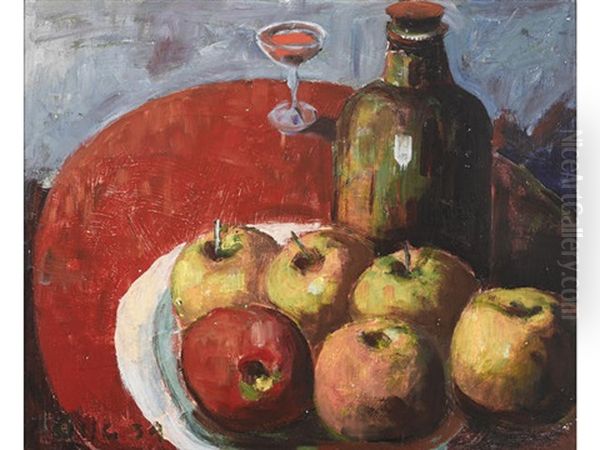
A crucial catalyst for many Bay Area artists, including Gile, was the Panama-Pacific International Exposition (PPIE) held in San Francisco in 1915. This grand event featured a vast art exhibition that included works by European Impressionists, Post-Impressionists, and even some Fauves and Cubists. Seeing works by artists like Claude Monet, Paul Cézanne, Vincent van Gogh, Paul Gauguin, Henri Matisse, and André Derain firsthand likely had a profound impact, reinforcing Gile's own inclinations towards modern color and form.
The Society of Six: A Brotherhood of Color
By the early 1920s, Gile had become a key figure among a group of like-minded painters based primarily in the East Bay. These artists shared a dissatisfaction with the prevailing academic styles and a common enthusiasm for painting directly from nature (en plein air) with bold colors and vigorous brushwork. According to accounts, it was Gile himself who suggested they formalize their association. Around 1917, the group began coalescing, and by the early 1920s, they became known as the Society of Six.
Gile is widely recognized as the founder and charismatic leader of this group. The other core members were August F. Gay, Maurice Logan, Louis Siegriest, William H. Clapp, and Bernard von Eichman. These six artists formed a close-knit circle, frequently embarking on painting excursions together into the Oakland hills, along the Alameda waterfront, or further afield into Marin County and the countryside. They shared meals, critiqued each other's work, and pushed one another towards greater artistic innovation.
Their philosophy centered on capturing the immediate sensation of the landscape, emphasizing light, color, and form over meticulous detail. They employed high-keyed palettes, often using unmixed colors straight from the tube, and applied paint with energetic, visible brushstrokes. Their approach was direct, honest, and infused with a palpable sense of joy and discovery in the act of painting itself. Gile's home, particularly a cabin he rented in Oakland and later his houseboat in Belvedere, often served as a gathering place for the group.
Exhibiting Modernism: The Oakland Art Gallery
The primary venue for the Society of Six's public exposure was the Oakland Art Gallery (a precursor to the Oakland Museum of California). William H. Clapp, one of the Six, became the gallery's director in 1918, providing a sympathetic platform for their work. Starting in 1923 and continuing annually until 1928, the Society of Six held group exhibitions at the gallery. These shows were often met with bewilderment, and sometimes hostility, by conservative critics and the public, who found their bright colors and seemingly unfinished technique jarring.
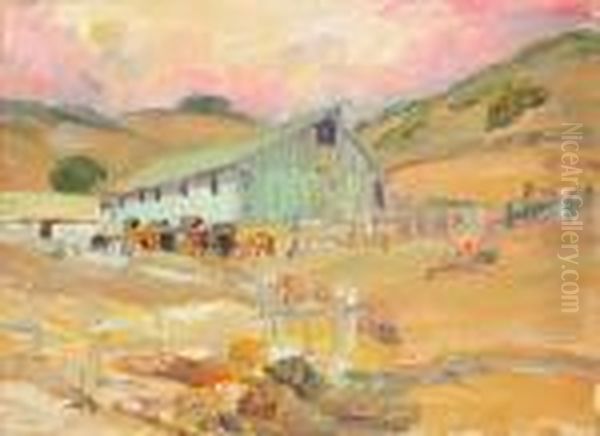
Despite the often-negative critical reception during their active years, the Society of Six exhibitions were significant events in the Bay Area art scene. They represented a bold challenge to the established artistic norms and showcased a distinctly modern approach rooted in the California landscape. Gile, as the group's elder statesman and arguably its most daring colorist, was frequently singled out, both for praise by the few sympathetic viewers and for condemnation by the traditionalists.
The collaborative spirit of the Six was paramount. While each artist maintained his individual style, their shared commitment to modern principles created a cohesive and powerful group identity. They learned from each other, inspired each other, and collectively forged a path for modern art in Northern California. Their association, though relatively short-lived in terms of formal exhibitions (dissolving by the early 1930s due to various factors including the Great Depression and members moving away), had a lasting impact.
Gile's Artistic Style: Color, Light, and Expression
Selden Connor Gile's mature style is characterized above all by its audacious use of color. Deeply influenced by the French Fauves like Matisse and Derain, Gile employed color not just descriptively but emotionally and structurally. He would juxtapose intense blues, vibrant greens, fiery oranges, and rich purples to convey the brilliance of the California light and his own subjective response to the scene. Hillsides might be rendered in patches of pure yellow and violet, shadows could be deep blue or crimson, and water might shimmer with unexpected hues.
His brushwork was equally expressive. Gile often applied paint thickly (impasto), leaving visible strokes that contribute to the energy and texture of the canvas. Forms were simplified, focusing on essential shapes and masses rather than intricate detail. This approach allowed him to capture the underlying structure and rhythm of the landscape, whether depicting the rolling East Bay hills, the waterfront scenes of Oakland and Alameda, or the dramatic coastline and towns of Marin County.
Light was a constant preoccupation. Gile masterfully captured the unique clarity and intensity of California light, showing how it defined forms, created strong contrasts, and saturated colors. His paintings often seem to radiate warmth and energy, reflecting the artist's deep connection to the environment he portrayed. While primarily known for landscapes, Gile also produced compelling still lifes, applying the same principles of bold color and simplified form to arrangements of fruit, pottery, and household objects, such as the notable Red Table Cloth (c. 1927).
Life in Marin County: New Vistas
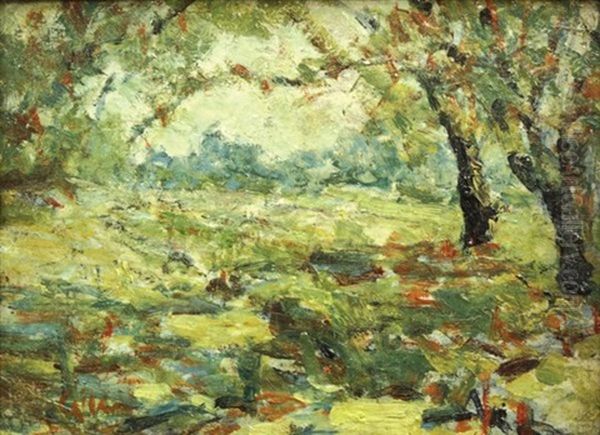
Around 1927, Gile left Oakland and moved across the bay to Marin County. He lived for a time in Tiburon and later, famously, on a houseboat (or ark) moored in the Belvedere lagoon. This move marked a shift in his surroundings and, to some extent, his subject matter. The picturesque towns, rolling hills, and waterfront views of Marin provided new inspiration. Works from this period often depict the charming houses nestled on hillsides, the sailboats on the bay, and the distinctive profile of Mount Tamalpais.
His Belvedere houseboat became a social hub, continuing the tradition of gatherings from his Oakland days, though perhaps with a changing cast of characters as the original Society of Six began to drift apart. Life in Marin seemed to suit his bohemian spirit. Anecdotes suggest a life lived with gusto, focused on painting and camaraderie, though sources also hint at increasing personal difficulties, possibly including struggles with alcohol, in his later years.
Despite these challenges, Gile continued to paint prolifically through the 1930s. While the intense, almost explosive color of his peak Society of Six period might have moderated slightly in some later works, his commitment to expressive brushwork and strong composition remained. Paintings like Destination, Marin County (c. 1938) and Marin Ranch (1939) showcase his enduring ability to capture the essence of the Northern California landscape with vibrancy and personal vision.
Notable Works: A Legacy in Paint
Selden Connor Gile left behind a significant body of work, much of which resides in major museum collections and private hands. Several paintings stand out as representative of his style and contribution:
Stinson Beach (c. 1919): An early example of his developing modernism, likely showing the influence of Impressionism but pushing towards bolder color and simplification, capturing the dynamic coastal environment.
Boat and Yellow Hills (c. 1920s): A classic Society of Six-era landscape, likely depicting the East Bay hills, characterized by its high-keyed palette, simplified forms, and energetic brushwork, embodying the group's plein air ethos.
Red Table Cloth (c. 1927): A powerful still life demonstrating Gile's mastery of color and composition within a different genre. The intense red of the tablecloth anchors the composition, set against complementary blues and greens, showcasing his Fauvist sensibilities. This work is held by the San Francisco Museum of Modern Art (SFMOMA).
Tiburon (various dates): Gile painted the town of Tiburon numerous times after moving to Marin County. These works often feature the town's distinctive architecture climbing the hillsides, with the bay waters in the foreground, rendered in his characteristic vibrant palette.
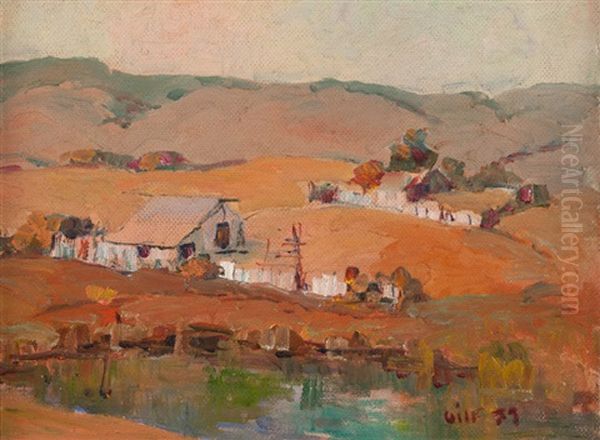
Still Life with Trees and Mountains (date uncertain): This title suggests a combination of genres, likely featuring a still life arrangement set against a landscape backdrop, allowing Gile to explore color and form relationships across different scales.
Spring (date uncertain): Likely a landscape celebrating the renewal of nature, probably rendered with the fresh, bright greens and blues typical of his optimistic response to the California seasons.
Marin Ranch (1939): A later work, exhibited posthumously in retrospectives like the 1983 "A Feast for the Eyes" show at the Civic Arts Gallery in Walnut Creek. It demonstrates his continued engagement with the Marin landscape, possibly with slightly more subdued tones but retaining his characteristic compositional strength.
Destination, Marin County (c. 1938): Another significant late landscape capturing the unique character of the Marin environment.
These works, among many others, illustrate Gile's consistent vision and his ability to translate the visual excitement of the California scene into paint.
Context and Contemporaries: Gile's Place in Art History
Selden Connor Gile and the Society of Six occupied a unique position in American art. They were geographically removed from the East Coast centers of modernism like New York, yet they developed a parallel and equally vital form of expressive painting. Their work can be seen as a West Coast counterpart to the explorations of artists associated with Alfred Stieglitz's circle, such as John Marin or Marsden Hartley, although their style was distinctly their own, deeply rooted in the California environment.
Within California, the Six represented a significant departure from the earlier generation of California Impressionists, such as Guy Rose, William Wendt, and Granville Redmond, whose work, while often beautiful, adhered more closely to traditional Impressionist techniques and palettes. The Six, alongside other independent figures like E. Charlton Fortune and Maynard Dixon (who explored different facets of modernism), pushed California art in a new direction.
Gile's direct influences, as noted, were primarily European Post-Impressionists (Cézanne, Van Gogh, Gauguin) and Fauves (Matisse, Derain). He absorbed these influences not derivatively, but by integrating their principles of color and form into his own deeply personal response to his immediate surroundings. His role as a mentor and leader within the Society of Six also positions him as an influential figure for his fellow members: August Gay, Louis Siegriest, Maurice Logan, William H. Clapp, and Bernard von Eichman all benefited from his artistic energy and vision.
Exhibitions, Collections, and Enduring Legacy
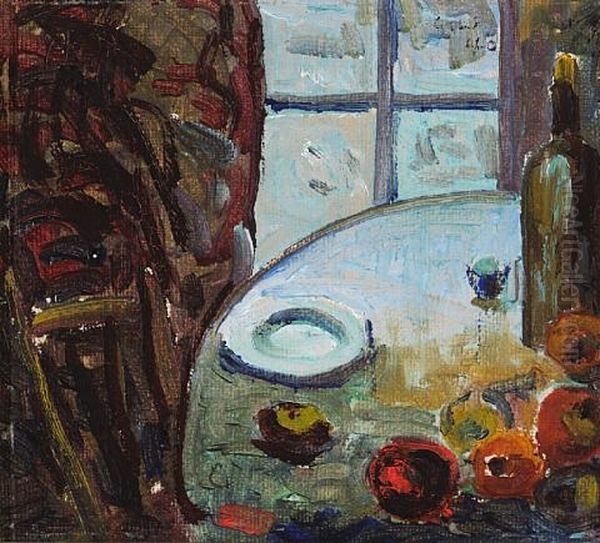
While the Society of Six faced resistance during their active years, Selden Connor Gile's work gained significant recognition posthumously. Major retrospective exhibitions, such as "A Feast for the Eyes" in 1983, helped solidify his reputation and introduce his art to new generations. His paintings are now highly sought after by collectors and are included in the permanent collections of important institutions.
Key public collections holding Gile's work include the Oakland Museum of California (which has a particularly strong collection of Society of Six paintings), the San Francisco Museum of Modern Art (SFMOMA), the Los Angeles County Museum of Art (LACMA), the Crocker Art Museum in Sacramento, and various university collections, including potentially the Helen Moncharsh Living Trust associated with UC Berkeley and the California College of the Arts. His work also appears periodically at auction houses like Bonhams.
Selden Connor Gile died in San Rafael, California, in 1947. His legacy is that of a pioneering modernist who brought an unparalleled vibrancy and emotional intensity to the painting of the California landscape. As the driving force behind the Society of Six, he played a crucial role in establishing a modern art movement in Northern California, one characterized by its bold color, expressive technique, and direct engagement with the natural world. His paintings remain a testament to his unique vision and his profound connection to the light and land of his adopted state. He remains a key figure for understanding the diverse and dynamic history of American modernism.